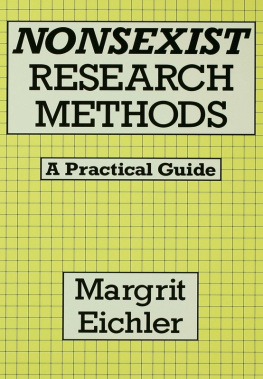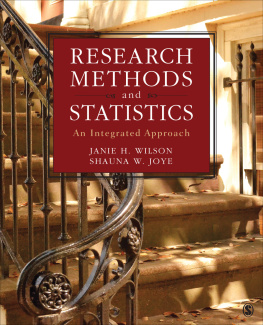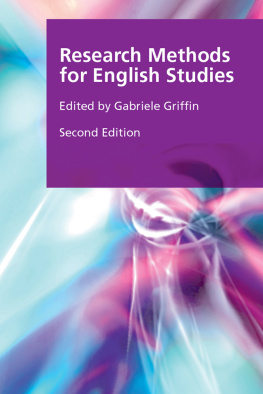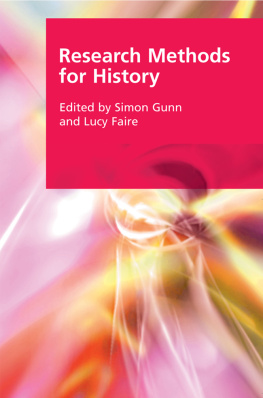Margrit Eichler - Nonsexist Research Methods
Here you can read online Margrit Eichler - Nonsexist Research Methods full text of the book (entire story) in english for free. Download pdf and epub, get meaning, cover and reviews about this ebook. year: 1988, publisher: Routledge, genre: Children. Description of the work, (preface) as well as reviews are available. Best literature library LitArk.com created for fans of good reading and offers a wide selection of genres:
Romance novel
Science fiction
Adventure
Detective
Science
History
Home and family
Prose
Art
Politics
Computer
Non-fiction
Religion
Business
Children
Humor
Choose a favorite category and find really read worthwhile books. Enjoy immersion in the world of imagination, feel the emotions of the characters or learn something new for yourself, make an fascinating discovery.
- Book:Nonsexist Research Methods
- Author:
- Publisher:Routledge
- Genre:
- Year:1988
- Rating:4 / 5
- Favourites:Add to favourites
- Your mark:
- 80
- 1
- 2
- 3
- 4
- 5
Nonsexist Research Methods: summary, description and annotation
We offer to read an annotation, description, summary or preface (depends on what the author of the book "Nonsexist Research Methods" wrote himself). If you haven't found the necessary information about the book — write in the comments, we will try to find it.
Nonsexist Research Methods — read online for free the complete book (whole text) full work
Below is the text of the book, divided by pages. System saving the place of the last page read, allows you to conveniently read the book "Nonsexist Research Methods" online for free, without having to search again every time where you left off. Put a bookmark, and you can go to the page where you finished reading at any time.
Font size:
Interval:
Bookmark:
Published in 1988 by Allen and Unwin, Inc.
Reprinted in 1991 by
Routledge
An imprint of Routledge, Chapman and Hall, Inc.
29 West 35 Street
New York, NY 10001
Published in Great Britain by
Routledge
11 New Fetter Lane
London EC4P 4EE
Copyright 1991 by Routledge, Chapman and Hall, Inc.
Printed in the United States of America
All rights reserved. No part of this book may be reprinted or reproduced or utilized in any form or by any electronic, mechanical or other means, now known or hereafter invented, including photocopying and recording, or in any information storage or retrieval system, without permission in writing from the publishers.
Library of Congress Cataloging-in-Publication Data
Eichler, Margrit.
Nonsexist research methods.
Bibliography: p.
Includes index.
1. Social sciences Research. 2. Sexism. I. Title.
H62.E453 1987 300.72 87-11477
ISBN 0-04-497044-7
ISBN 0-415-90605-9 (pb)
British Library Catalouging in Publication Data
Eichler, Margrit
Nonsexist research methods: a practical guide.
1. Sexism in social science research
I. Title.
300.72 H62
ISBN 0-04-497044-7
ISBN 0-415-90605-9
The Four Primary Problems
The Three Derived Problems
This book is the result of several years of study in the area of sexism in scholarship and nonsexist alternatives. It has thus profited immensely from the various debates and publications on this topic. Many but not all of the authors who have contributed to this debate are cited in the text. I have also profited over the years from discussions with students. In particular, however, I am grateful to Paula Caplan, Marjorie Cohen, Jill Vickers, Maiylee Stephenson, and Wendy McKeen for reading and commenting on the entire manuscript, and to Robert Biym and Rhonda Lenton for reading and commenting on portions of the manuscript. The comments of the readers also resulted in several important changes in the final version. Finally, my greatest debt goes to Linda Williams, who provided invaluable research assistance at various points during the writing of the book.
I would also like to thank the following people for providing me with specific references: Paula Caplan, Ursula Franklin, Ester Greenglass, Thelma McCormack, Paul Olson, Ruth Pierson, Monica Townson, and Paul Wiesenthal.
The guidelines contained in the book have gone through many revisions and applications. Part of them were developed within the framework of a federal committee, the Canadian Womens Studies Advisoiy Committee of the Secretary of States Womens Programme. This committee was established to advise the federal government on where to locate five chairs on womens studies endowed by the Canadian government for the five geographic regions of Canada. Having received a broad rather than narrow mandate, the committee added the development of a set of guidelines for nonsexist research to its agenda. The entire committee, consisting of June Gow (chair), Donna Greschner, Gilberte Leblanc, Donna Mergler, Beth Percival, Charlotte Thibault, Jennifer Stoddart, and myself screened and discussed two earlier versions of the guidelines contained in this book. In particular, Donna Mergler contributed to the present shape ofthe guidelines.
Finally, I wish to acknowledge gratefully the excellent copy-editing done by Patricia Miller. Lisa Freeman-Miller of Allen &, Unwin was a dream come true in what you hope for in an editor.
Over a century ago, a schoolmaster named Edwin A. Abbott wrote an amusing Romance of Many Dimensions, entitled Flatland, space.
When the Square returns to his own country, he eagerly tries to spread the Gospel of Three Dimensions, but is predictably put into prison as a dangerous lunatic, where he languishes at the end of the novel, absolutely destitute of converts.
The following is an excerpt in which our hero, the Square, tries to convince the King of Lineland that there are, in fact, two dimensions. He argues that, in addition to Linelands motions of Northward and Southward, which are the only directions in which lines can move in Lineland, there is another motion, which he calls from right to left:
KING: Exhibit to me, if you please, this motion from left to right.
I: Nay, that I cannot do, unless you couldstep out of your Line altogether.
KING: Out of my Line? Do you mean out ofthe world? Out of Space?
I: Well, yes. Out of your Space. For your Space is not the true Space. True Space is a Plane; but your Space is only a Line.
KING: If you cannot indicate this motion from left to right by yourself moving in it, then I beg you to describe it to me in words.
I: If I cannot tell your right side from your left, I fear that no words of mine can make my meaning clear to you. But surely you cannot be ignorant of so simple a distinction.
KING: I do not in the least understandyou. (Abbott, 1952:62)
Like the King of Lineland, we have been brought up in an intellectually limited universe. Our dilemma is that all our major concepts, our way of seeing reality, our willingness to accept proof, have been shaped by one dimension one sex rather than by two. For as long as we remain within this intellectual universe, we are incapable of comprehending its limitations, believing it to be the only world that exists. In order to truly understand our universe, we must create a vantage point that allows us to observe it both for what it is and for what it is not. Not an easy task, as the Square found out when he tried to explain the existence of left and right to a person who had never experienced them.
Similarly, none of us has ever lived in a nonsexist society: moving toward nonsexist scholarship is comparable to trying to comprehend a dimension that we have not materially experienced. We can describe it in theoretical terms, but we cannot fully appreciate its nature until we are able to lift ourselves out of our current confining parameters. This involves becoming aware of sexism in research and starting to eliminate it.
Sexism in research was first recognized as a major problem around the mid-1970s. While books and articles that pointed out the problem existed before that time, it is only since the mid-1970s that critiques have appeared with some regularity and in more mainstream outlets.
In the early 1970s and continuing into the 1980s, various organizations, Nevertheless, sexism in research is still badly understood. Even less well understood is how to conduct research in a nonsexist manner.
This book has two major objectives: (1) to present an analysis of sexism in research that enlarges our understanding of this problem and sensitizes students and researchers to sexism in its various manifestations; and (2) to provide guidelines for solving the problem that offer clear and concise means of creating nonsexist alternatives.
Most analyses of sexism in research focus either on one discipline or subject area or else on one type of sexism. The term sexism suggests that we are dealing with one problem that may manifest itself in different areas differently, but which nevertheless is a single basic problem what one might call the big blob theory of sexism.
This book takes a different approach. Sexism is here broken down into seven different types. Of these seven types, four are primary a sexist problem as such, and rectifying it. In other words, the seven problems are intended to serve as tools to facilitate the recognition and correction of sexism in research, rather than as an ultimate system of categorization.
Font size:
Interval:
Bookmark:
Similar books «Nonsexist Research Methods»
Look at similar books to Nonsexist Research Methods. We have selected literature similar in name and meaning in the hope of providing readers with more options to find new, interesting, not yet read works.
Discussion, reviews of the book Nonsexist Research Methods and just readers' own opinions. Leave your comments, write what you think about the work, its meaning or the main characters. Specify what exactly you liked and what you didn't like, and why you think so.









